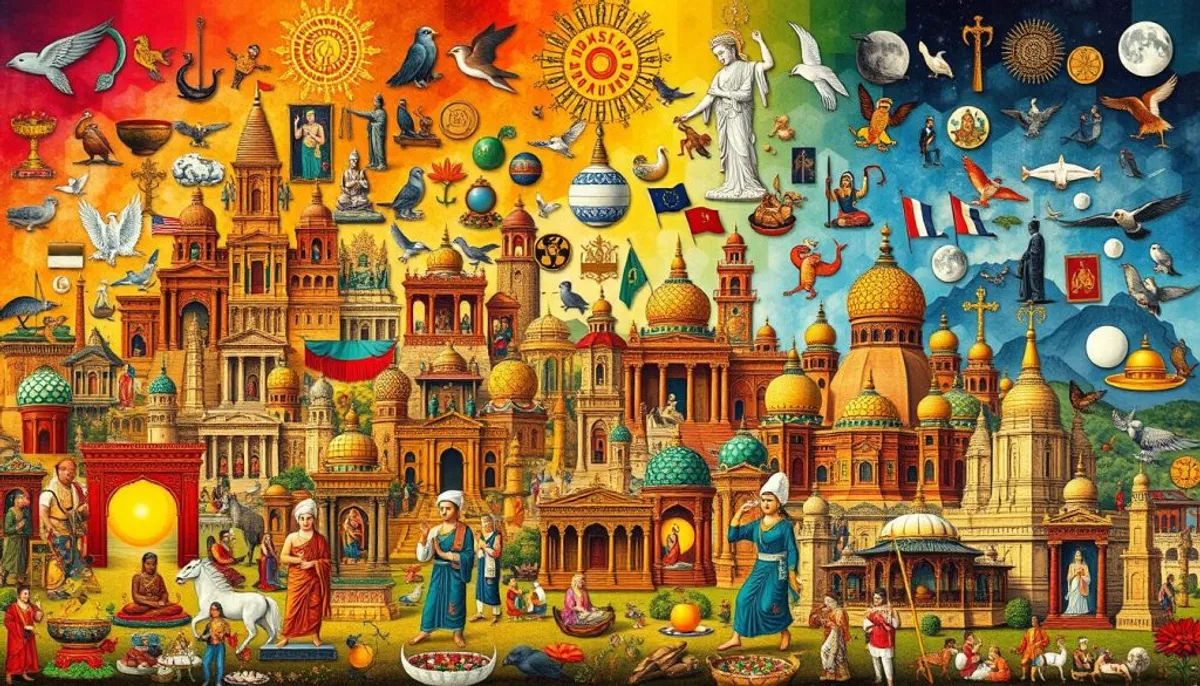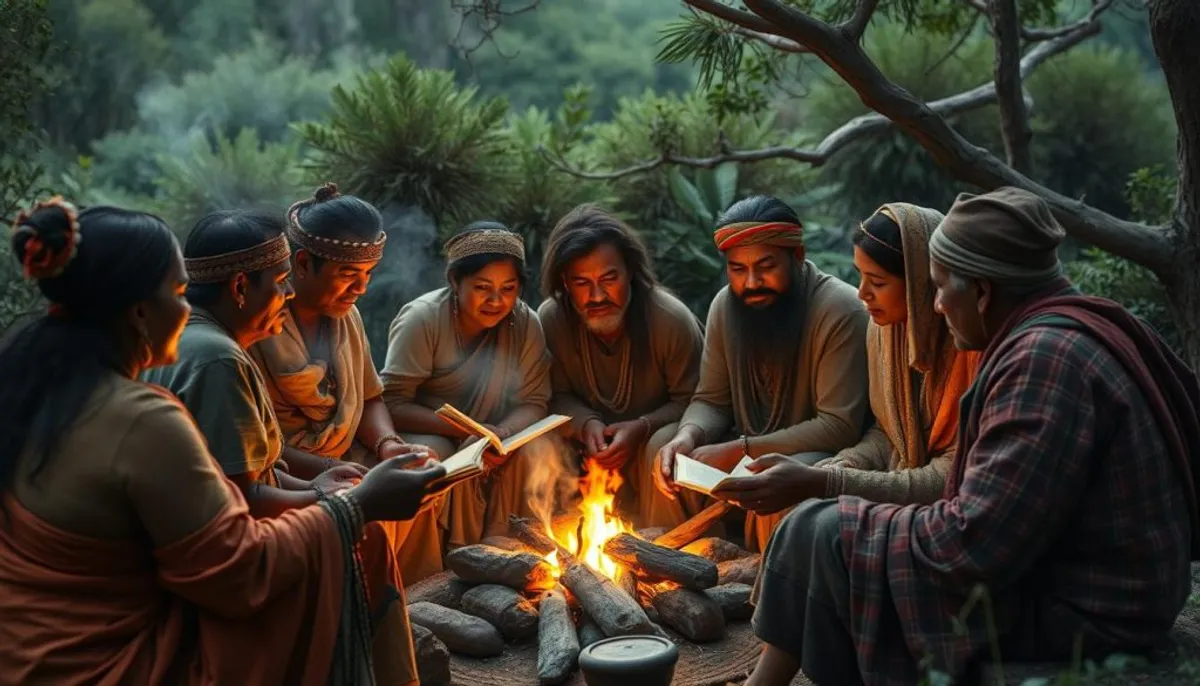The religious tradition is an essential foundation of our society. It brings together beliefs and practices passed down from generation to generation. These traditions create a unique bond between man and the sacred, influencing our perception of the spiritual world.
The roots of the religious tradition extend back to antiquity. The concept of Apostolic Tradition, for example, was codified by Irenaeus of Lyons around 190. Over the centuries, this idea has profoundly shaped current religious practices.

Religion, a global phenomenon, exists in all cultures. It explores deep existential questions and seeks to resolve them. Rites, ceremonies, and worship are essential in these traditions, establishing a tangible link with the sacred. Furthermore, the Hispanophone culture enriches this diversity by bringing its own beliefs and practices.
In Burkina Faso, the religious tradition plays a crucial role. Terms like “rog-n-miki” or “kudumde” demonstrate the synergy between culture and tradition. This linguistic richness highlights the deep-rootedness of religious practices in Burkinabè identity.
What is a religious tradition
A religious tradition is a set of beliefs, rites, and practices passed down through generations. It forms the spiritual foundation of a community of believers.
The etymological definition of the term tradition
The etymology of the word “tradition” comes from the Latin “traditio,” meaning “transmission.” This term evokes the passing of religious teachings from one generation to the next.
The fundamental components of a religious tradition
A religious tradition is based on several key elements:
- The beliefs: doctrines and spiritual principles
- The rites: sacred ceremonies and practices
- The holy texts: foundational writings of the religion
- The community organization: social structure of the believers
The role of transmission in tradition
Transmission is essential for perpetuating a religious tradition. It occurs orally or in writing, ensuring the continuity of spiritual teachings. This transmission helps preserve the identity and values of the religious community over time.
| Component | Mode of transmission | Example |
|---|---|---|
| Beliefs | Oral and written | Catechism |
| Rites | Practice and observation | Baptism |
| Holy texts | Written and recitation | Bible, Quran |
The history and evolution of religious traditions
The study of the history of religions reveals the evolution of traditions over the centuries. From early manifestations to contemporary adaptations, beliefs and religious practices have undergone profound transformations. This dynamic continues to shape the current religious landscape.
The origins of traditions in antiquity
In antiquity, each city had its own religion, with varied rites and customs. In ancient Greece, the gods of Olympus were worshipped, while Egypt honored Ra and Osiris. These local traditions laid the foundations of the history of religions.
The evolution of traditions through the ages
Time has shaped religious traditions. Christianity, emerging in the Roman Empire, gradually gained influence. Islam, among others, also emerged, introducing new beliefs and practices.

The influence of cultures on religious traditions
Cultures have profoundly influenced religious traditions. As religions spread, they adopted local practices. Christianity, for example, integrated pagan festivals, illustrating the cultural influence on religious practices.
| Religion | Origin | Cultural influence |
|---|---|---|
| Christianity | Middle East | Integration of pagan festivals |
| Islam | Arabian Peninsula | Adaptation to local customs |
| Buddhism | India | Syncretism with Asian beliefs |
Understanding the history of religions allows for grasping the evolution and enrichment of traditions in the face of varied cultures. This historical perspective highlights the complexity and diversity of the current religious landscape.
The different forms of traditional transmission
The transmission of religious traditions occurs through several channels, each essential for the preservation of beliefs. Oral transmission, fundamental, allows for the sharing of stories and teachings from one person to another. It often uses poetry, with rhymes and alliterations, to aid in memorization.
The holy texts play a crucial role in written transmission. They set forth doctrines and rules of life in writing. Catholicism, for example, considers Tradition as a source of Revelation, complementary to the Scriptures. It defines the interpretation of the holy books and the fundamental dogmas.

Rites and ceremonies embody transmission through practice. They allow believers to live their faith in a concrete and communal way. Teaching, for its part, occurs within groups of believers, ensuring the training of new generations in the principles of their religion.
Each religious tradition has developed its own modes of transmission, adapted to its history and culture. This diversity ensures the richness and longevity of spiritual legacies through the ages, thus highlighting the importance of traditions.
The role of tradition in major religions
Tradition occupies a central place in major religions, particularly in Christianity. It plays a crucial role in the transmission of beliefs and religious practices across generations, thus emphasizing the importance of traditions.
Tradition in Christianity
In Christianity, tradition is regarded as an important source of divine revelation. It complements the Scriptures and helps interpret the sacred texts. Catholicism and Orthodoxy place great importance on tradition, while Protestantism emphasizes the Scriptures more.
Tradition in the Catholic Church
The Catholic Church sees tradition as complementary to the Scriptures. It holds that divine revelation is transmitted both through sacred texts and through oral tradition. This view was reaffirmed at the Council of Trent in the 16th century.
Tradition in the Orthodox Church
The Orthodox Church places paramount importance on tradition. It considers it the Spirit that carries the Word. For Orthodox Christians, tradition is the means by which the Holy Spirit guides the Church in its interpretation of the Scriptures.
The Protestant perspective on tradition
Protestantism, unlike Catholicism and Orthodoxy, emphasizes the principle of “sola scriptura” (Scripture alone). This approach prioritizes the authority of the Scriptures over tradition while recognizing the importance of history and the Christian heritage.
| Branch of Christianity | Role of tradition |
|---|---|
| Catholicism | Complementary to the Scriptures |
| Orthodoxy | The Spirit bearer of the Word |
| Protestantism | Secondary to the Scriptures |
Conclusion
Religious traditions constitute a crucial foundation of our cultural heritage. They define the values and norms of our communities, as demonstrated by Félix Mathieu and Guy Laforest in their 2015 study. This research compared educational approaches in France, England, and Quebec, highlighting the lasting impact of religious traditions on these methods.
The religious diversity manifests in the 104 countries explored across five continents. These countries harbor varied beliefs, from Christianity to Hinduism, including Islam and Buddhism. This diversity underscores the importance of traditions in shaping cultural and spiritual identities on a global scale.
The evolution of religious traditions, from the term “paradosis” in the New Testament to the writings of the Church Fathers, demonstrates their dynamism. Despite social transformations, the cultural heritage of religious traditions continues to have a profound impact on our current societies. This highlights their essential role in understanding the diversity of beliefs and spiritual practices.
RelatedRelated articles


